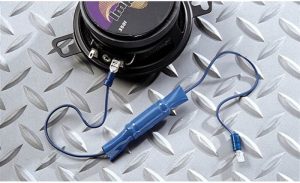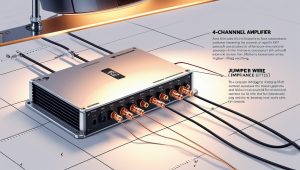So, you’ve got a thumping subwoofer in your car, but instead of clean, deep bass, you’re hearing a nasty, rattling oscillation? Don’t worry, you’re not alone! Many car audio enthusiasts struggle with subwoofer oscillation, that annoying buzzing or humming that can damage your equipment. This beginner’s guide will walk you through adjusting your car amplifier to tame that unruly subwoofer and unleash the smooth, powerful bass you crave. Let’s dive in!
Contents
- Getting Started: Amp & Subwoofer Basics
- Understanding Oscillation: The Problem
- Identifying Oscillation in Your System
- Gain Control: The First Adjustment
- Fine-Tuning the Low-Pass Filter (LPF)
- Bass Boost: A Careful Approach
- Phase Alignment: Finding the Sweet Spot
- Subwoofer Placement: Makes a Big Difference
- Listening Tests: Your Ears Are Key
- Troubleshooting: Persistent Oscillation
Getting Started: Amp & Subwoofer Basics
Before we tackle oscillation, let’s ensure you understand the fundamentals. Your car amplifier (amp) is the powerhouse boosting the signal from your head unit to your subwoofer. The subwoofer itself is a specialized speaker designed for low-frequency sounds – the deep bass notes. Understanding the relationship between these two components is crucial for proper adjustment. Think of the amp as the engine and the subwoofer as the car; they need to work together harmoniously.
Crucially, your amplifier likely has several controls: gain, low-pass filter (LPF), bass boost, and possibly phase. These controls are your weapons in the fight against oscillation. We’ll explore each one in detail, but remember, making small adjustments is key. Large, sudden changes can worsen the problem. Start with small tweaks and listen carefully to the results.
Understanding Oscillation: The Problem
Oscillation, in the context of car audio, is a self-sustaining vibration. Essentially, your subwoofer and amplifier are feeding off each other’s energy, creating a feedback loop that results in that unpleasant buzzing or humming sound. This can be caused by a variety of factors, including improper gain settings, conflicting frequencies, and poor subwoofer placement. Moreover, prolonged oscillation can seriously damage your amplifier and subwoofer, potentially leading to costly repairs or replacements.
Therefore, addressing oscillation isn’t just about improving sound quality; it’s about protecting your equipment. Imagine a seesaw constantly tipping back and forth, never settling. That’s essentially what’s happening in your system when oscillation occurs. The goal is to find the balance point where your subwoofer produces clean, powerful bass without the unwanted vibrations.
Identifying Oscillation in Your System
Identifying oscillation is usually pretty straightforward. You’ll hear a distinct buzzing, humming, or rattling sound, often even when no music is playing. This sound usually increases in intensity as you turn up the volume. Furthermore, it might be more pronounced at certain frequencies or volumes. Pay close attention to the sound – is it a consistent hum or a more erratic, chaotic noise?
To help isolate the problem, try turning down the gain on your amplifier. If the oscillation reduces or disappears, you’ve confirmed that the amplifier is involved. Similarly, temporarily disconnecting the subwoofer will also help determine if the problem originates from the subwoofer itself or the interaction between the amp and the sub. These simple tests can point you in the right direction for troubleshooting.
Gain Control: The First Adjustment
The gain control on your amplifier determines how much signal it boosts. Setting the gain too high is a common cause of oscillation. Start by turning your gain control all the way down. Then, slowly increase it while playing music at a moderate volume. Listen carefully for any signs of oscillation. The key is to find the highest gain setting where the bass is strong and clean, without any buzzing or humming.
Remember, you want a clean, powerful bass response, not maximum output. Many people mistakenly crank the gain to the max, leading to distortion and oscillation. Gradually increase the gain, making small adjustments and listening carefully after each one. Your goal is to find the sweet spot where the bass is full and deep, but the system remains stable. Patience is key here.
Fine-Tuning the Low-Pass Filter (LPF)
The low-pass filter (LPF) on your amplifier determines the highest frequency your subwoofer will reproduce. Setting the LPF too high can cause the subwoofer to try to reproduce frequencies it’s not designed for, leading to oscillation. Conversely, setting it too low can result in a muddy, weak bass response. Experiment with different LPF settings, starting with a lower frequency and gradually increasing it.
Typically, subwoofers are designed to handle frequencies in the 20-80 Hz range. Start around 80 Hz and gradually lower the frequency, listening carefully for any improvement in clarity and a reduction in oscillation. Remember, the goal is to find the optimal frequency range where your subwoofer produces clean, deep bass without any unwanted vibrations or distortion. Small adjustments are your friend here.
Bass Boost: A Careful Approach
Many amplifiers include a bass boost control. While this can enhance the bass response, overuse can contribute to oscillation. Start with the bass boost turned off or at its minimum setting. Gradually increase it, making small adjustments and listening carefully for any changes in sound quality or the appearance of oscillation. As with gain, you want to find a balance between enhanced bass and system stability.
If you notice oscillation when using the bass boost, reduce the setting immediately. Remember, a clean, well-defined bass is superior to a booming, distorted one. A small amount of bass boost can sometimes improve the overall sound, but it’s often better to rely on the gain and LPF settings for primary bass control. Overusing the bass boost is a common mistake.
Phase Alignment: Finding the Sweet Spot
The phase control on your amplifier adjusts the timing of the subwoofer’s output. Improper phase alignment can lead to cancellation or reinforcement of certain frequencies, potentially causing oscillation. Experiment with the phase setting (usually 0 or 180 degrees), listening carefully to see which setting produces the most balanced and powerful bass. This is often trial and error.
The “sweet spot” will vary depending on your specific car and subwoofer placement. In some cases, one phase setting will produce a noticeably fuller and more powerful bass response while the other might lead to a thinner or muddier sound. This adjustment is often overlooked but can significantly impact the overall sound quality and stability of your system.
Subwoofer Placement: Makes a Big Difference
Believe it or not, the placement of your subwoofer can significantly affect its performance and its propensity to oscillate. Experiment with different locations in your car’s trunk or cabin. Avoid placing the subwoofer directly against a metal surface, as this can amplify vibrations and contribute to oscillation. Instead, try to position it in a more isolated and cushioned location.
Consider the acoustics of your car. Some locations might create standing waves or resonances that exacerbate oscillation. Ideally, you want the subwoofer to be positioned in a relatively open space, away from hard surfaces that can reflect sound waves. Experimenting with different placements might require some trial and error, but the difference in sound quality can be dramatic.
Listening Tests: Your Ears Are Key
Throughout the adjustment process, rely on your ears. Objective measurements are helpful, but nothing beats subjective listening. Play a variety of music genres with strong bass lines to assess the system’s response across different frequencies. Listen for any signs of oscillation, distortion, or muddiness. Make small adjustments, listen, and repeat.
Pay attention to the overall balance and clarity of the sound. You want a tight, controlled bass that complements the rest of your audio system, not a booming, overwhelming sound that overshadows other frequencies. Remember, the goal is a harmonious blend of all frequencies, not just maximum bass output. Your ears are your most valuable tool in this process.
Troubleshooting: Persistent Oscillation
If you’ve tried all the above adjustments and still experience oscillation, there might be a more serious problem. Check your wiring for shorts or loose connections. Ensure your subwoofer is compatible with your amplifier. A faulty amplifier or subwoofer could also be the culprit. In such cases, consulting a professional car audio installer might be necessary.
Don’t hesitate to seek help if you’re struggling to resolve the oscillation. A professional can diagnose the problem and recommend solutions, potentially saving you from further damage to your equipment. Remember that persistence and patience are key to achieving the best possible sound quality from your car audio system.
Taming a subwoofer’s oscillation requires patience, careful listening, and a systematic approach. By understanding the basics of your amplifier and subwoofer, and by making small, incremental adjustments, you can achieve a clean, powerful, and enjoyable bass response. Remember, your ears are your best guide! Happy listening!






